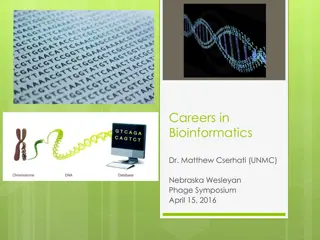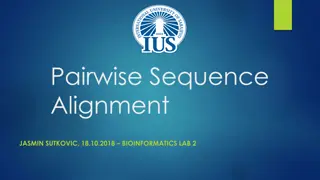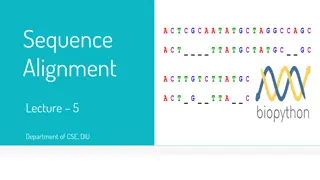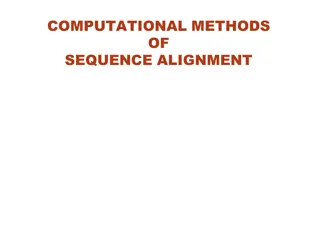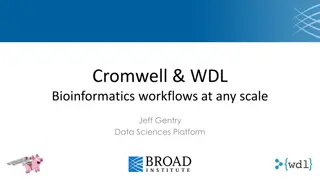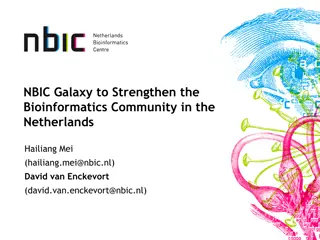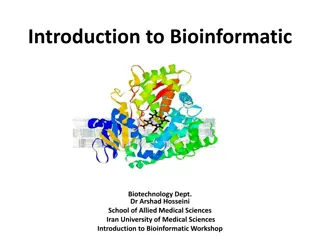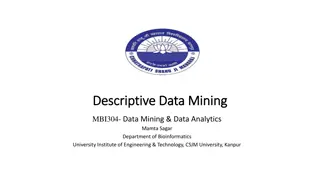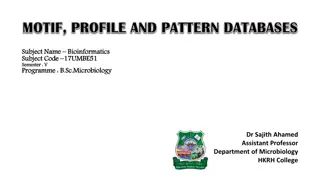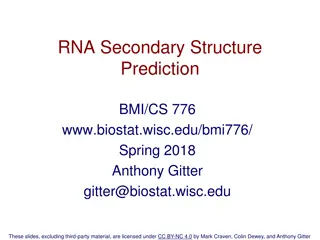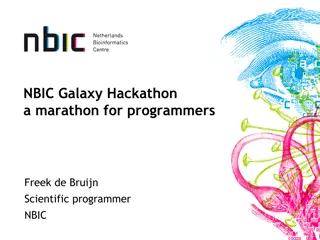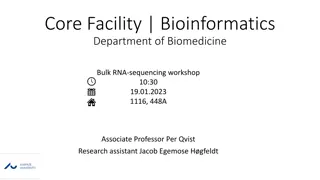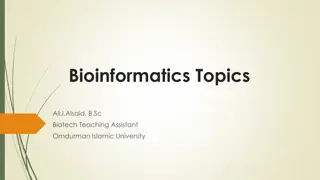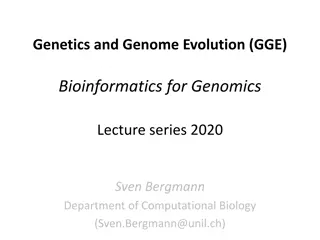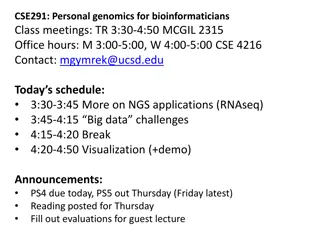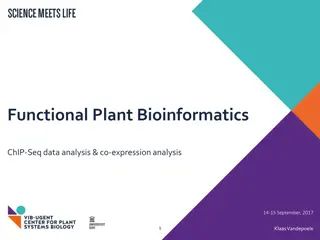Understanding Molecular Docking in Bioinformatics
Explore the world of molecular docking in bioinformatics through in silico approaches, learning about protein-ligand interactions, modes of docking, different docking approaches, and the theory of enzymes. Discover how this computational method helps predict the binding affinity and conformation of
4 views • 41 slides
Understanding Longest Common Subsequences in Bioinformatics
DNA Sequence Alignment is a crucial task in bioinformatics, where dynamic programming helps in finding the best alignment between DNA strings efficiently. The Longest Common Subsequence (LCS) problem aims to discover the longest shared subsequence between two strings, offering applications in DNA si
1 views • 21 slides
Bioinformatics
Bioinformatics involves analyzing biological sequences through sequence alignment to uncover functional, structural, and evolutionary insights. This process helps in tasks like annotation of sequences, modeling protein structures, and analyzing gene expression experiments. Basic steps include compar
0 views • 6 slides
Bioinformatics for Genomics Lecture Series 2022 Overview
Delve into the Genetics and Genome Evolution (GGE) Bioinformatics for Genomics Lecture Series 2022 presented by Sven Bergmann. Explore topics like RNA-seq, differential expression analysis, clustering, gene expression data analysis, epigenetic data analysis, integrative analysis, CHIP-seq, HiC data,
0 views • 36 slides
Exploring Bioinformatics: Careers, Research, and Disciplines
Bioinformatics is an interdisciplinary field combining biology, computer science, mathematics, and statistics. Dr. Matthew Cserhati, a bioinformatics programmer, has a background in biology and software engineering. His research includes projects like NeuroAIDS database development and Staphylococcu
2 views • 46 slides
Exploring the World of Bioinformatics Databases
Bioinformatics databases are essential tools in handling molecular biological data, classified into sequence and structure databases. Primary databases store raw data, while secondary databases contain curated information for research. Examples include GenBank, Protein Data Bank, and SWISS-Prot.
1 views • 38 slides
Gene Prediction: Similarity-Based Approaches in Bioinformatics
Gene prediction in bioinformatics involves predicting gene locations in a genome using different approaches like statistical methods and similarity-based approaches. The similarity-based approach uses known genes as a template to predict unknown genes in newly sequenced DNA fragments. This method in
1 views • 40 slides
Understanding Plant Tissue Culture Media and Their Importance in In Vitro Growth
Plant tissue culture media play a crucial role in the in vitro growth and morphogenesis of plant tissues. The composition of culture media depends on the specific plant species and the type of material used for culture. Various types of media, such as White's medium, MS medium, B5 medium, N6 medium,
0 views • 6 slides
An Overview of Biological Databases in Bioinformatics
Biological databases play a crucial role in bioinformatics, storing vast amounts of data related to nucleotide sequences, protein sequences, and more. These databases are publicly accessible and essential for research in biological fields. Primary databases, such as GenBank, EMBL, and DDBJ, contain
0 views • 13 slides
Understanding Plant Pathology: Importance, Scope, and Objectives
Plant pathology, also known as phytopathology, is the study of plant diseases and their management. It covers the causes, symptoms, and impact of pathogenic organisms on plants. The field aims to understand the interactions between plants and pathogens, develop control methods, and reduce losses in
0 views • 6 slides
Introduction to Plant Physiology: Exploring the Functioning of Plants
Plant physiology is a crucial subdiscipline of botany that delves into the processes and functions operating within plants. This field closely examines areas like plant morphology, ecology, cell biology, and genetics, shedding light on vital processes such as photosynthesis, respiration, and more. T
1 views • 7 slides
Understanding Sequence Alignment and Tools in Bioinformatics
Explore the concepts of homology, orthologs, and paralogs in bioinformatics, along with different types of sequence alignment such as global, local, and semi-global. Learn about popular alignment tools like Blast and Fasta and how they are used for analyzing sequences. Dive into the world of NCBI an
0 views • 32 slides
Understanding Sequence Alignment Methods in Bioinformatics
Sequence alignment is crucial in bioinformatics for identifying similarities between DNA, RNA, or protein sequences. Methods like Pairwise Alignment and Multiple Sequence Alignment help in recognizing functional, structural, and evolutionary relationships among sequences. The Needleman-Wunsch algori
0 views • 18 slides
Understanding Sequence Alignment in Bioinformatics
Sequence alignment in bioinformatics involves arranging DNA, RNA, or protein sequences to identify similarities for functional, structural, and evolutionary insights. It helps in comparing genes, proteins, and discovering conserved regions, highlighting the importance of global and local alignment m
0 views • 19 slides
Understanding Plant Tissue Culture: Techniques and Applications
Plant tissue culture involves maintaining and growing plant cells, tissues, or organs in artificial mediums under controlled conditions. It allows the regeneration of whole plants from small plant parts or cells. Hormones like auxins, cytokinins, and gibberellins are used in the process. Proper envi
3 views • 5 slides
Explore Cromwell and WDL Bioinformatics Workflows
Discover the world of Cromwell and WDL bioinformatics workflows at any scale, with emphasis on the scalability and flexibility of the execution engine. Learn about the Workflow Description Language and basic plumbing concepts. Unveil the multiple backends for maximum flexibility in Cromwell's execut
0 views • 14 slides
Plant Tissue Culture Methods for Growth and Reproduction Study
Plant tissue culture methods such as root tip culture, shoot-tip culture, leaf culture, flower culture, and anther and pollen culture allow for the study of growth, reproduction, and genetic variations in plants. These techniques involve culturing various plant parts under sterile conditions to inve
1 views • 20 slides
Understanding Plant Quarantine and Phytosanitary Measures
Plant quarantine involves efforts to prevent the entry, establishment, or spread of foreign pests through legal restrictions on plant and plant product movement. It is crucial for safeguarding plant health, food production, and ecosystems. Phytosanitary measures aim to ensure the health of plants by
0 views • 33 slides
Understanding Mineral Nutrition in Plants
Mineral nutrition in plants involves the acquisition of essential elements in the form of inorganic ions from soil, followed by their absorption and utilization in various plant processes. Around 60 different elements have been reported in plants, with 30 being essential for plant growth. These esse
0 views • 39 slides
Plant Propagation Techniques in Nursery Environment
Learn about plant propagation techniques within a nursery environment, including nursery operations, potting seedlings, plant protection, weed control, packing of nursery plants, and crafting tissues for plant growth. Explore the essential tasks involved in nurturing seedlings and trees before they
0 views • 17 slides
Strengthening the Bioinformatics Community in the Netherlands
NBIC Galaxy, in collaboration with BioAssist, plays a pivotal role in bolstering the bioinformatics community in the Netherlands. With a focus on training, collaboration, and sharing tools, Galaxy enables scientists to leverage national HPC infrastructures for analysis, further enhancing research ca
0 views • 17 slides
Exploring Bioinformatics: Applications and Significance in Biotechnology
Bioinformatics involves the analysis of molecular biology data using information systems, computer science, and other techniques. It plays a crucial role in various fields like disease prevention, treatment, animal modeling, forensic analysis, and more, aiming to improve the quality of life and enha
0 views • 17 slides
Understanding Data Mining and Analytics in Bioinformatics
Data mining in bioinformatics involves descriptive analysis of statistical attributes, creating predictive models, and empirically verifying them. By employing algorithms from various fields, data mining helps in tasks like classification, clustering, association analysis, and regression. The proces
0 views • 14 slides
The Power of Unix Command Line Basics for Text Processing in Bioinformatics
Unix Shell commands such as sort, cut, uniq, join, paste, sed, grep, awk, wc, diff, comm, and cat are essential for text processing in bioinformatics. These tools allow seamless manipulation of text data without the need for intermediate files, making file processing efficient and powerful. By pipin
0 views • 19 slides
Plant Health Initiatives at the 27th Technical Consultation Among Regional Plant Protection Organizations - Memphis, Tennessee
The 27th Technical Consultation in Memphis, Tennessee focused on plant health initiatives by the International Regional Organization for Plant and Animal Health. OIRSA emphasized four key technical areas: plant health, animal health, agricultural quarantine, and food safety. Projects included addres
0 views • 13 slides
Plant Growth Hormones and Defense Mechanisms: Understanding Plant Responses to the Environment
Plant growth hormones and defense mechanisms play crucial roles in how plants respond to environmental stimuli such as water, sunlight, gravity, and more. From auxins promoting cell growth to gibberellins stimulating flowering, this presentation educates on the intricacies of plant hormones and thei
1 views • 13 slides
Understanding Plant Hormones and Their Role in Growth and Development
Plant hormones are vital compounds that regulate various processes in plant growth and development. They are mostly organic and can be gases. These hormones are produced in one part of the plant and transported to other parts where they induce physiological effects. The main phytohormones include Au
0 views • 125 slides
Understanding Motifs in Bioinformatics
Bioinformatics studies the patterns of sequences called motifs, which play significant roles in biological functions. Conserving information from DNA or proteins, motifs can be predicted de novo using various tools and strategies. Exploring these motifs aids in understanding regulatory elements and
0 views • 15 slides
Exploring RNA Secondary Structure Prediction in Bioinformatics
RNA secondary structure prediction is a key concept in bioinformatics, encompassing features like stems, loops, and bulges. This presentation delves into the importance of RNA beyond mRNA, highlighting rRNA, tRNA, and regulatory RNA roles. The canonical base pairs A-U and C-G shape the single-strand
0 views • 20 slides
Insights from NBIC Galaxy Hackathon: Building Community and Learning Experiences
NBIC Galaxy Hackathon, a marathon for programmers, brought together bioinformatics experts and programmers to collaborate on innovative projects. The event showcased the community-building efforts, technological advancements, and learning experiences gained through modifying Galaxy, a bioinformatics
0 views • 9 slides
Exploring Whales and DNA through Bioinformatics Adventures
Dive into a fascinating journey through scenarios involving whale bones, wildlife crimes, and DNA mysteries. Uncover the secrets of mitochondrial DNA and bioinformatics in an interactive webquest. Join the experts Jayne Ricciardi, Beth Marass, and special guest Katie Lodes in this educational expedi
0 views • 4 slides
Bioinformatics Core Facility at Aarhus University: Services and Contact Details
The Bioinformatics Core Facility at Aarhus University offers bioinformatics training, consultation, data analysis, research collaboration, and more services for scientists. They provide expertise in NGS analyses, data formatting, knowledge dissemination, and pricing models. Contact them for bioinfor
0 views • 32 slides
Overview of Bioinformatics Topics in Informatics and Biology
Bioinformatics covers various topics such as informatics, biology, programming, statistics, and operating systems. It emphasizes the importance of skills in data management, programming, and statistical analysis for interpreting experimental data types like DNA sequencing and protein structures.
0 views • 55 slides
Exploring the Fundamentals of Plant Pathology: Understanding Viruses in Plant Diseases
Delve into the world of plant pathology with Mr. Vikash Kumar, as you learn about the nature, structure, and transmission of viruses affecting plants. Explore the important characteristics of plant viruses, their unique properties, and how they interact within plant cells. Gain insights into viral d
0 views • 14 slides
Efficient Ways to Download Genome Files for Bioinformatics Analysis
Obtain valuable insights into retrieving genome files for bioinformatics analysis utilizing multiple methods such as connecting via Finder, using Filezilla for FTP access, and executing curl commands on Xanadu. Learn how to access coding sequences, feature tables, nucleotide sequences, and encoded p
0 views • 38 slides
Understanding Genomics and Bioinformatics in Genetics Evolution
Delve into the world of genomics and bioinformatics through the Genetics and Genome Evolution (GGE) lecture series by Sven Bergmann. Explore topics such as RNA-seq analysis, differential expression, gene expression measurement techniques, and integrative analysis with epigenetic data. Gain insights
0 views • 37 slides
Understanding NGS Applications in Bioinformatics
Explore the world of Next-Generation Sequencing (NGS) applications in bioinformatics, covering topics such as RNA sequencing, big data challenges, storing genomic datasets, querying genetic information, and data visualization. Dive into the complexities of sequencing technologies, gene expression co
0 views • 41 slides
Overview of Plant Quarantine and Disease Management
Plant quarantine is a crucial practice that involves regulating the movement of plants and plant products to prevent the spread of pests and diseases. Originating with the first law in France in 1860, plant quarantine now encompasses various methods such as embargoes and inspections to safeguard pla
0 views • 11 slides
Plant Bioinformatics Studies on ChIP-Seq Data Analysis
Plant bioinformatics researchers conducted experimental analyses and mapped gene regulatory networks using ChIP-Seq data. The studies involved exploring gene expression, regulatory interactions, and transcription factor binding sites. Techniques such as peak calling, motif finding, and peak annotati
0 views • 19 slides
Emerging Trends in Bioinformatics: Leveraging CUDA and GPGPU
Today, the intersection of science and technology drives advancements in bioinformatics, enabling the analysis and visualization of vast data sets. With the utilization of CUDA programming and GPGPU technology, researchers can tackle complex problems efficiently. Massive multithreading and CUDA memo
0 views • 32 slides




